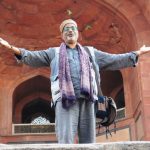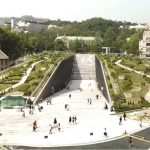-
A Career In Perspective
October 2012

Archt Prasanna Silva today is a senior Architect with experience in both the Government and Private Sector. In his retirement from the Public Sector he currently is working for Arch-Triad Consultants as a Consultant Architect working on projects related to institutional, educational and mixed development. Today in retirement he enjoys the company of his close-knit family and basically “works for pleasure”.
By Archt (Dr) Hiranthi Pathirana
He attributes choice of profession to his interest in geography and biology in school which made him keen on pursuing further studies in a field connected with social sciences and environmental studies. He was also influenced and inspired through his school environment, strong religious background and family environment.
Archt Prasanna’s school career commenced at St Aloysius College, Galle and concluded with distinction at Maris Stella College, Negombo, where he was the first student to gain admission to the University of Moratuwa to study Architecture. Subsequently he did post graduate studies in Town & Country Planning and Architectural Conservation of Sites and Monuments. Archt Prasanna also obtained specialised training in the fields related to Project Management, Housing & Urban Regeneration, Infrastructure Development, Environmental Assessment and Disability Access to buildings. His professional career commenced at Design Consortium Limited (DCL). Subsequently he joined the Public Sector which on hindsight he observes as a weak decision regarding his professional life.
He succinctly describes his personality and professional approach as ‘simple and open minded’. His architectural creativity has been influenced by his childhood years living within the old Dutch Fort in Galle, subsequently in Katana and Negombo where he experienced the rich heritage of British period buildings, church architecture and natural landscape of both sea and lagoon fronts and lush vegetation . “Although in my later years I have become an urbanite, my design creativity if any is definitely influenced by such vivid living experiences” he says. This maybe why although he likes working on designs on restricted sites his designs maintain the connection between indoors and the outdoors .
He is meticulous in his design process which commences with a detailed inspection of project sites to identify physical attributes both potential and constraints in relation to the Client’s requirements. Subsequently the brief would be reviewed and refined in order to develop the Architect’s brief. Thereafter much time would be spent on the conceptualising of the design in consultation with the client and other consultants on technical details until the client’s consensus is obtained for the Schematic Design Proposal. The challenges he faces in this processes are the difficulties in the acceptability of client, the usage of appropriate materials in the local context, availability of good quality materials, choice of alternative materials and getting services of quality conscious contractors.
Archt Prasanna describes his practice as, “being very personalised concentrating mainly on houses for different personalities”. He is particular not only about design but also the structural systems and infrastructure services of the design because they give more precision and order to design. He adds “it is very rarely that I am satisfied with the outcome although in most instances the clients are happy”
The most important attribute of a successful architect according to this senior architect is, “your creative talent, more than the interest. Skill which is also a key attribute could be developed through professional development.” On a personal note “I wish to mention that to become a successful architect in the financial sense one should be very business-minded,” he added. On the rewards of practicing Architecture he commented, “more than the financial benefits, I am privileged to have gained a group of appreciative clients who have now become the marketeers of my architectural practice!”
The Architect’s first major involvement with the SLIA was during Session 1985/86, under the guidance of the then president Late Prof. Archt Gemunu Fernando organising a Seminar for the membership on Development Regulations. From then on he was involved with organising the annual sessions. Archt Mihindu Keerthiratne in his term as President invited Archt Prasanna Silva to serve in the Council and as Secretary of Board of Architectural Education under chairmanship of the Late Archt Krishnapillai. He was elected Assistant Secretary of SLIA for Session 1987/88 and under the chairmanship of the Late Archt Kathi Ganeshan, was able to publish the first SLIA magazine. He remembers how, although elected Secretary SLIA for the Session 1995 /1996 he had to abruptly resign due to an accident which left him immobile. During Archt V N C Gunasekera’s tenure as President he had the privilege of contributing to his Plan on National Development especially on the aspects, Environment and Urban Development. Thereafter in 2001 he was invited to take the position of Chairman Board of Architectural Education (BAE) for Sessions 2001/2002 and 2002 /2003. He recalls that with “Archt Asoka Widanapthirana as Secretary, I was able to improve the examination procedure for SLIA Professional Practice Examinations, and the SLIA Annual Awards Ceremony”. He was once again elected Secretary for the Sessions 2007 /2008 and 2008 /2009 with Archt Jayantha Perera as President. During this Session, he was involved with the organising of ARCASIA Forum held in Colombo and the 50th Anniversary Celebrations of the Sri Lanka Institute of Architects. Later, currently he is the Chairman, Board of Architectural Publications for Session 2011/2012 and 2012 /2013 and is involved with improvement of all publications of the SLIA. He accepted a request made by SLIA in 2003 to take up the Post of the Director (Head) of Colombo School of Architecture (presently, City School of Architecture) managed by SLIA. During the five years (2003 – 2007) with Archt Asoka Widanapatirana then Chairman Board of Management he was successful in improving the School; Academic Work, School Infrastructure, Extracurricular Activities and Students’ Overseas Study Tour. Currently he continues to serve as Director of the Board of Management of City School of Architecture and Member of the Board of Academic Studies and continues to serve in the improvement of the Architectural Education.
Fully committed to his commitments at SLIA and design work, he does not hesitate to take responsibility “either good or bad”. He believes in being guided by prior experience as against inventing new processes. “It is time saving” he says.
In conclusion he voices his concerns about the future, “I am concerned about the responsibility for architectural work being assigned to those not trained in local practices, environmental conditions, and social issues. This would result in socially desolate, eco unfriendly buildings in our cities. The ideal scenario would be if all the architectural consultancies and local architects could have a stake for their contributions on the attributes of the local flavour, environmental considerations and social contexts.”













